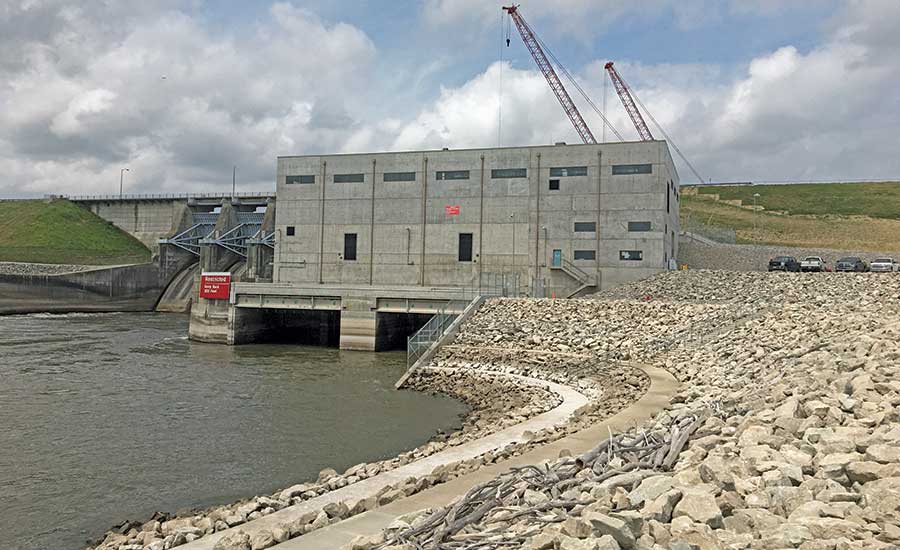Red Rock Dam in Pella, Iowa, Becomes a Hydrodam

To make room for the new structures, a 69-ft-tall cut in the embankment dam had to be made.
PHOTOS COURTESY OF MRES

The penstocks supply water to Red Rock Dam’s vertical, Kaplantype hydraulic turbines, and each turbine is directly connected to generators.

A new switchyard supports the powerhouse. A cofferdam protected the downstream work areas from the river. The location was closed off by a rockfill dike during construction to allow the powerhouse excavation to proceed in the dry.



The Red Rock Hydroelectric Plant near Pella, Iowa, was commissioned late last year adding a new hydroelectric power-generating facility to an existing flood control dam that previously had no generation capacity. This six-year, $400-million retrofit the existing dam provides power for up 18,000 homes in the area.
Originally a flood control dam on the Des Moines River and Lake Red Rock near Pella, Red Rock was built by the U.S. Army Corps of Engineers in 1969. The USACE still owns and operates the flood control portion of the dam, but the Western Minnesota Municipal Power Agency sold the bonds necessary to make the investment to add the powerhouse and make it the second-largest hydroelectric power-generating facility in Iowa. It’s operated by Missouri River Energy Services, a utility that has a power supply agreement that entitles MRES to the output of all WMMPA-owned facilities. MRES has 61 member municipal electric systems in Iowa, Minnesota, North Dakota and South Dakota. Stantec was the owner’s engineer and designer-of-record.
“The original concept included three concrete penstocks, which are large diameter water-conveyance conduits,” said Rachael Bisnett, a senior associate in Stantec’s Charlotte office. “After review the plan was revised to two larger penstocks, each centered within one of the concrete gravity dam monoliths. This change maximized the concrete cover relative to the monolith joints and reduced the width of the intake structure.”
Stantec specified vertical Kaplan-style turbine generators to maximize annual power generation rates based on an assessment of the historic reservoir level and discharge data. Each unit has a rated capacity of 18 MW but can generate up to 27.5 MW, for a total generation of up to 55 MW under high flows. An intake structure 99-ft-high by 112-ft wide by 60-ft deep contains two water passages, two emergency wheel gates, and bulkhead slots and storage. The two penstocks are 280 ft long, with an inside diameter of 21 ft. Both penstocks penetrate the concrete gravity’s dam monoliths and are lined in steel downstream of the dam. The powerhouse measures 150-ft-wide by 98-ft-deep by 144-ft-high.
The design also included a 69-ft-high cantilevered retaining wall that uses 130-ft-tall T-shaped concrete diaphragm walls socketed into rock. This wall retains the existing embankment dam along the new intake approach channel for the hydroelectric facility. A second diaphragm wall along the embankment dam formed a seepage cutoff during construction and after. The cutoff wall is 100-ft-long and ties into the end of the concrete gravity dam.
Crews from contractor Ames Construction began the project in 2014 and spent the first 18 months installing support structures to prepare for powerhouse construction. By 2016, construction on the new powerhouse downstream of the Red Rock Dam and the upstream intake structure began. Features of the powerhouse include spiral case water passages to send water to the turbines and draft tube water passages to discharge water into the tailrace channel.
Throughout 2017, crews from Ames completed the powerhouse. In 2018 the two penstocks were constructed and the downstream exterior structure of the powerhouse was enclosed. Ames crews also completed required electrical connections.
The upstream diaphragm wall along the new intake channel had to support a 69-ft-tall cut in the embankment dam. Case-Bencor JV, as subcontractor to Ames, constructed that wall using abutting T-shaped elements up to 130-ft tall. These reinforced elements included 5-ft-wide stems that extended 16 ft into embankment from the back of the 5-ft-thick face of the diaphragm wall, which made them a total of 21 ft across. Each element could weigh up to 90 tons. A self-consolidating tremie concrete mix with an initial set time of 16 hours was developed to facilitate placement of each element. The tremie concrete achieved compressive strengths around 7,000 PSI.
The construction sequence for each T-shape required three passes of a hydromill trench cutter. Each a vertical pass of the 10.5-ft-long by 5-ft-wide hydromill cutter head from the ground surface to the bottom of the rock socket.
“There would be the bite for the flange part of the T and there’d be a bite for the backside of the stem and then another bite to make the full T-shaped slurry wall,” said Raymond Wahle, director of power supply operations at MRES.
After the upstream intake structure was completed and tested, Ames’s crews cored through the Red Rock Dam to complete the water passages through the 60-year-old flood control dam to enable the passage of water to the new powerhouse. After commissioning, the new hydropower plant began generating power in early 2021.











